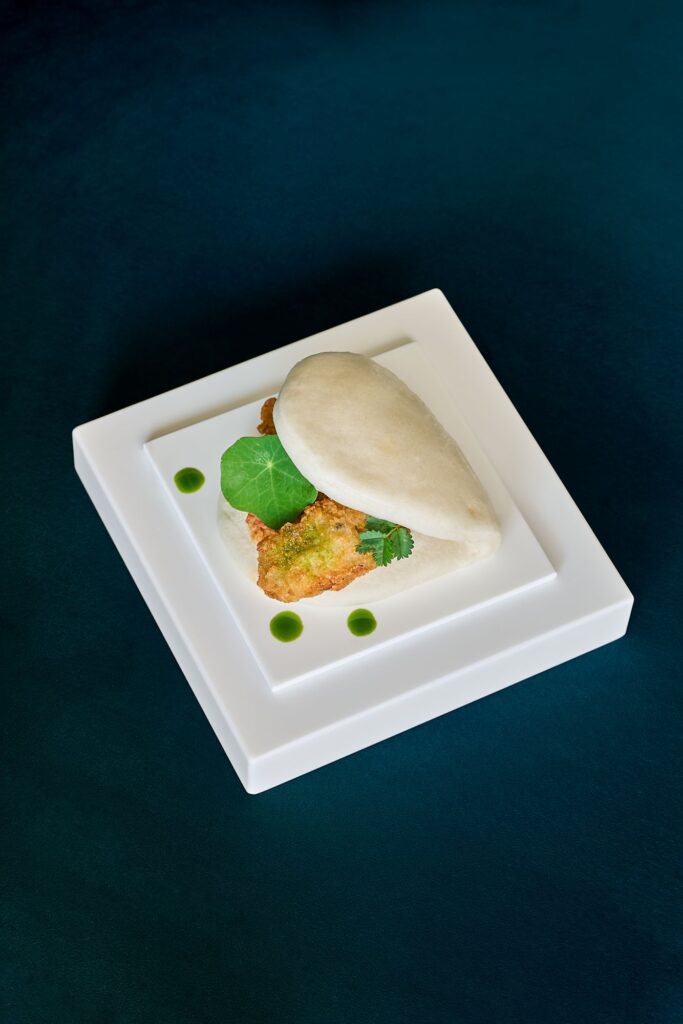Now in its ninth edition, the Calendario Perazza solidarity project features the athletes of Prosecco DOC Imoco Volley, Benetton Rugby, and Nutribullet Treviso Basket who posed with enthusiasm to support and promote the initiative. The proceeds from sales will be split equally between the Pediatrics Department at Ca’ Foncello Hospital in Treviso and the Veneto Oncology Institute (IOV), continuing a partnership that has lasted for several editions.
The 2026 calendar also features the Treviso Comic Book Festival: three festival illustrators added their own creative touches to enhance the photographs. This collaboration combines sports, imagination, and visual art, while upholding the charitable mission that has defined the calendar since its inception.



In the Prosecco DOC Imoco Volley section, the players shine in elegant black-and-white outfits, surrounded by a cascade of colorful graphic elements created by illustrator Isabella Bersellini. Flowers, stars, and flowing lines accentuate the athletes’ silhouettes, emphasizing their athleticism and individual personalities.
For Benetton Rugby, Osvaldo Casanova brings the action to life with a series of vibrant and dynamic illustrations. Stylized silhouettes of players in motion trail bright streaks of color that wrap around their bodies, creating a striking and expressive visual impact.
For the Nutribullet Treviso Basket calendar, Paolo Gallina created stylized urban scenes in black and white. His visual storytelling fuses street culture with sports identity, blending everyday life and city details with the athletes’ relaxed – and sometimes – playful poses.
Giancarlo Guidolin, President of the Prosecco DOC Consortium, said: “We are delighted to take part once again in a project that brings together sport, creativity, and solidarity. Our denomination has always supported the local community and initiatives that help those facing difficult challenges. Contributing to the Pediatrics Department at Ca’ Foncello Hospital and to the IOV allows us to transform the values of sport and culture into real, concrete support for families. We hope this edition inspires even more people to join forces and ease the burden of those in delicate situations.”
As per tradition, at the end of August, Prosecco DOC bubbles arrive at the Lido to accompany some of the most significant moments organised during the Venice International Film Festival.
Rolling Stone celebrates cinema at the Lido di Venezia
 On 28 August, Prosecco DOC took part in the highly anticipated event organised by the editorial staff of the historic Rolling Stone magazine on the terrace of the Hotel Ausonia Hungaria, one of the most evocative locations on the Lido di Venezia. This event was held to celebrate the release of the magazine’s special issue, dedicated entirely to cinema and its protagonists.
On 28 August, Prosecco DOC took part in the highly anticipated event organised by the editorial staff of the historic Rolling Stone magazine on the terrace of the Hotel Ausonia Hungaria, one of the most evocative locations on the Lido di Venezia. This event was held to celebrate the release of the magazine’s special issue, dedicated entirely to cinema and its protagonists.
The evening featured a highly acclaimed talk with Valeria Golino and Valeria Bruni Tedeschi, two of the most beloved actresses and directors on the Italian and international film scene. The meeting was reserved for a select audience, composed of the press and personalities from the worlds of cinema, culture and branding. At the end of the talks, guests were treated to a refined aperitif with Prosecco DOC, cocktails and a DJ set.
The experience was also enriched by the “Il Divano di Rolling Stone” format: video interviews with the talents in competition and special guests, filmed on the sand of the Lido and aboard the Maxi Yacht Prosecco DOC Shockwave3 against the enchanting backdrop of the Venice lagoon.
Venice International Film Festival and Kineo Award
 The Rolling Stone event was part of a busy few days for the Consortium, which, as usual, was hosted in the Veneto Region’s space inside the iconic Hotel Excelsior, a crossroads for actors, directors and producers before the Red Carpet parade. Among the highlights were the presence of the Prosecco DOC Imoco Volley team and several meetings dedicated to the Milan Cortina 2026 Winter Olympics and Paralympics, with the presentation of the Olympic and Paralympic Torches and cultural projects related to the Games.
The Rolling Stone event was part of a busy few days for the Consortium, which, as usual, was hosted in the Veneto Region’s space inside the iconic Hotel Excelsior, a crossroads for actors, directors and producers before the Red Carpet parade. Among the highlights were the presence of the Prosecco DOC Imoco Volley team and several meetings dedicated to the Milan Cortina 2026 Winter Olympics and Paralympics, with the presentation of the Olympic and Paralympic Torches and cultural projects related to the Games.
Finally, Veneto-Friuli sparkling wines, as Official Sparkling Wine, were present for the fifth consecutive year at the Kineo Award gala evening, held on 30 August in the splendid setting of Ca’ Sagredo overlooking the Grand Canal.
Wine, cinema and sport in the cellars of the Denomination
From 25 to 30 August, Cinema in Cantina returns, the end-of-summer event that, for the eighth consecutive year, transforms six cellars of the Prosecco Denomination into charming open-air cinemas surrounded by rows of vines in the cool countryside.
Organised by Ginko Film in collaboration with the Sole Luna Association – A bridge between cultures and promoted by the Prosecco DOC Protection Consortium, the festival offers six evenings, each of which will begin with a guided tour of the winery and a tasting of Prosecco DOC in the company of athletes, authors, producers and experts, followed by the screening of the selected film.
The theme for 2025: sport
The central theme of the 2025 edition is sport, an activity that has always united different generations and cultures. ‘Like cinema, sport is a universal language. It tells of individual and collective challenges, reflects social changes and showcases human potential in overcoming limits and barriers. It is a theme that speaks to the heart through profound values: burning passion, daily sacrifice, and the explosive joy of victory. Whether it is the solitary determination of an athlete or the collective strength of a team, sport generates stories that inspire every viewer,” say the organisers.
‘Cinema in Cantina is a renewed project that authentically combines wine culture and the art of cinema,’ says Giancarlo Guidolin, president of the Protection Consortium. “Our cellars, which have always been places of hospitality and sharing, are transformed for the occasion into spaces for cultural experiences, offering guests the opportunity to experience Prosecco DOC not only as a product, but as an expression of a territory. The 2025 edition, entirely dedicated to the theme of sport, represents a further stimulus to reflect on the universal values that Prosecco DOC shares with sporting activity: commitment, passion and team spirit. Cinema thus becomes a bridge between emotion, storytelling and knowledge, made possible thanks to the quality of the screenings curated by Sole Luna. The whole experience is rounded off with moments of dialogue and conviviality that strengthen the bond with our Denomination.
Expected guests
Among the most eagerly awaited special guests are the champions of Prosecco DOC Imoco Volley Conegliano; skier Asja Zenere; climber Angelika Reiner; Massimo Sartori, the coach who discovered Jannik Sinner; Paralympic athlete Martina Caironi, star of the film Niente sta scritto (Nothing is Written), and Tommaso Romanelli, director and son of the naval engineer whose story is told in the film No More Trouble.
Six stories in six evenings
The selection of films in the programme intertwines authorial perspectives, personal testimonies and archive material.
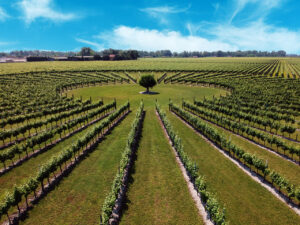
25 August, 8 p.m. – I Magredi, Domanins (PN) | Fiore Mio by Paolo Cognetti – the story of a high-altitude hike that talks about nature, endangered glaciers and solitude – with alpine skier Asja Zenere in attendance.
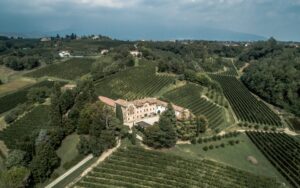 26 August, 8.30 p.m. – Serena Wines, Ville d’Arfanta, Tarzo (TV) | Le Streghe d’Oriente by Julien Faraut – the incredible story of the Japanese women’s volleyball team of the 1960s, which became a national symbol and cultural phenomenon – in the presence of the director and Prosecco DOC Imoco Volley Conegliano.
26 August, 8.30 p.m. – Serena Wines, Ville d’Arfanta, Tarzo (TV) | Le Streghe d’Oriente by Julien Faraut – the incredible story of the Japanese women’s volleyball team of the 1960s, which became a national symbol and cultural phenomenon – in the presence of the director and Prosecco DOC Imoco Volley Conegliano.
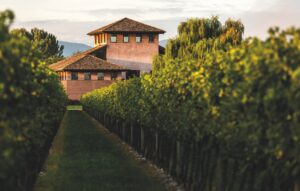
27 August at 8:00 p.m. – Pitars, San Martino al Tagliamento (PN) | Niente sta scritto by Marco Zuin – the story of Martina Caironi, the fastest athlete with prosthetic limbs in the world – in the presence of the director and the protagonist.
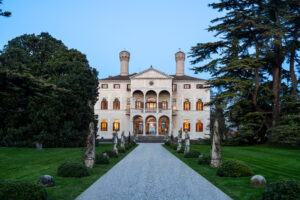 28 August, 8:00 p.m. – Castello di Roncade (TV) | Ninì by Gigi Giustiniani – an intimate and touching portrait of Nini Pietrasanta, a forgotten pioneer of mountaineering and mountain cinema – in the presence of producers Daniele Ietri and Eleonora Matropietro and climber Angelika Rainer.
28 August, 8:00 p.m. – Castello di Roncade (TV) | Ninì by Gigi Giustiniani – an intimate and touching portrait of Nini Pietrasanta, a forgotten pioneer of mountaineering and mountain cinema – in the presence of producers Daniele Ietri and Eleonora Matropietro and climber Angelika Rainer.
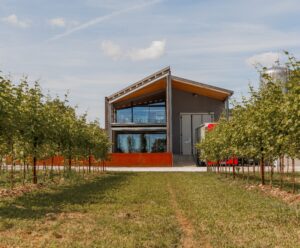
29 August, 8 p.m. – La Cantina Pizzolato, Villorba (TV) | Challengers by Luca Guadagnino – desire and competition through tennis and its emotional entanglements – in the presence of Massimo Sartori, tennis coach.
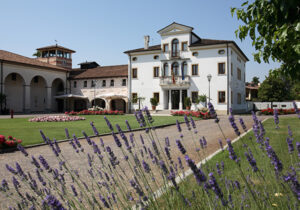 30 August, 8 p.m. – Casa Paladin, Annone Veneto (VE) | No More Trouble – What Remains of a Storm by Tommaso Romanelli – a sentimental investigation conducted by the son on the figure of his father, who died in a sailing accident – in the presence of director Tommaso Romanelli, Claudio Demartis, owner of Prosecco Doc Shockwave3, and Stefano Spangaro, captain of Prosecco Doc Shockwave3.
30 August, 8 p.m. – Casa Paladin, Annone Veneto (VE) | No More Trouble – What Remains of a Storm by Tommaso Romanelli – a sentimental investigation conducted by the son on the figure of his father, who died in a sailing accident – in the presence of director Tommaso Romanelli, Claudio Demartis, owner of Prosecco Doc Shockwave3, and Stefano Spangaro, captain of Prosecco Doc Shockwave3.
Info and reservations: Admission is free, but reservations are required (limited seating) by writing to solelunafest@gmail.com or contacting the host wineries directly.
The editorial project born from the collaboration between the Consorzio Prosecco DOC and the Vinibuoni d’Italia Guide brings us to Piedmont, to Serralunga d’Alba, where Michelangelo Mammoliti leads the visionary kitchen of La Rei Natura. With two Michelin stars, his cuisine tells a story of memory, nature, technique, and freedom.
Born into a family where food was always at the center, Mammoliti trained with some of the great masters of French gastronomy. Today, he carries forward a culinary project that speaks of sensations, seasons, and identity.
The Recipe:
Barbecued Spaghetti Cooked in Cuneo Prosciutto Crudo Extract
La Rei Natura – SERRALUNGA D’ALBA (CN)
Ingredients:
320 g Gragnano spaghetti – 100 g barbecue-infused butter – 800 g Cuneo Prosciutto Crudo extract – rosemary flowers – salt – Sarawak pepper – vegetable charcoal powder
This dish fuses the ancestral element of fire with the refinement of extraction. The spaghetti, briefly blanched, is finished risotto-style in a rich essence of Cuneo Prosciutto Crudo, infused with barbecue aromas, and topped with Sarawak pepper, rosemary flowers, and vegetable charcoal.
A preparation that evokes the forest, smokiness, and the intensity of the raw ingredients. On the palate, sweet, savory, and smoky notes alternate in a precise and enveloping progression. Few elements, immense sensory impact.
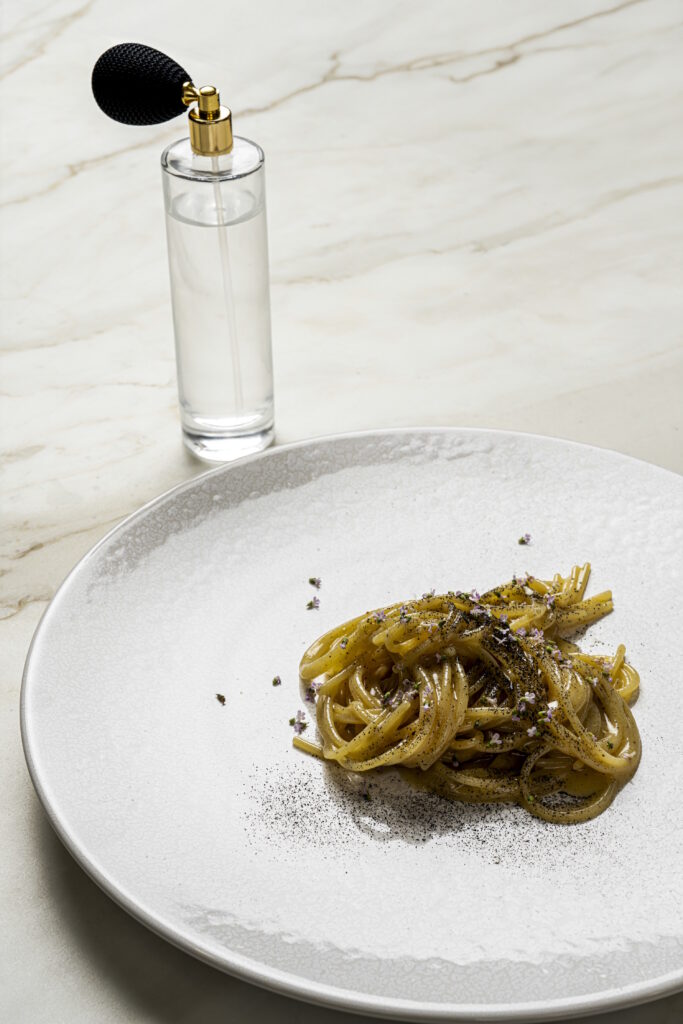
Preparation:
Blanch the spaghetti in salted water for 5 minutes, even though the pasta’s usual cooking time is longer. Continue cooking the spaghetti in a pan with the Cuneo Prosciutto Crudo extract for another 2 minutes. Add the barbecue-infused butter and finish with Sarawak pepper. Plate and garnish with rosemary flowers and a dusting of vegetable charcoal.
Pairing: Prosecco DOC Brut Nature
To support and accompany such sensory intensity, Alessandro Scorsone recommends Prosecco DOC Brut Nature. Dry, essential, and highly vertical, this wine both cleanses and refreshes the palate. Its structure and freshness complement the smoky notes with discretion and elegance.
A pairing that proves even the most radical expressions of contemporary cuisine can find a reliable and sophisticated companion in Prosecco DOC.
La ricetta: Bao farciti con ostriche di Scardovari fritte, ragù di frattaglie di coniglio e olio al cipollotto verde
Il Vizio – SINA BERNINI BRISTOL ROMA
Per i bao: 400 g di farina tipo 0 – 240 ml di acqua – 10 g di lievito di birra fresco 1 cucchiaino di zucchero semolato
Per il ragù di frattaglie di coniglio: 1 carota – 1 costa di sedano – 1 cipolla_200 g di fegatini di coniglio – 100 g di cuori di coniglio – 2 foglie di alloro – 1 rametto di rosmarino 1 pizzico di peperoncino in polvere – 1/2 bicchiere di vino bianco -1 cucchiaio di triplo concentrato di pomodoro -olio extravergine di oliva – sale
Per le ostriche fritte: 8 ostriche di Scardovari – olio extravergine di oliva dal gusto leggero
Per la pastella: 2 tuorli d’uovo – 2 cucchiai di farina – 1/2 bicchiere di panna liquida 1 albume – sale fine e sale in scaglie – pepe
Per olio al cipollotto verde: foglie verdi del cipollotto – olio di vinacciolo
Un amuse-bouche audace e raffinato. I bao, morbidi panini cotti al vapore, vengono farciti con un ragù intenso di frattaglie di coniglio e ostriche fritte in pastella, il tutto rifinito con un tocco aromatico di olio al cipollotto verde.
Un’esplosione di consistenze e sapori: la cremosità del ragù, la croccantezza dell’ostrica, la sapidità marina e la componente erbacea. Un boccone sensuale e complesso, che richiede un vino capace di accompagnare e bilanciare senza appesantire.
Passaggi:
Per i bao sciogliere il lievito di birra nell’acqua, insieme allo zucchero. Aggiungere alla farina e impastare fino a ottenere un composto omogeneo ed elastico. Lasciare riposare l’impasto coperto per circa 2 ore. Quando l’impasto avrà raddoppiato il suo volume, stendere l’impasto a circa 2 cm, con un coppapasta da 8-10 cm ritagliare dei dischi. Allungare leggermente i dischi con il matterello formando degli ovali. Ripiegare ogni ovale su se stesso inserendo un foglietto di carta da forno, in modo da non far attaccare l’impasto. Trasferire nel cestello per cottura a vapore foderato con carta da forno, coprire e lasciare lievitare per circa 15 minuti. Cuocere a vapore per circa 20 minuti. Togliere il cestello dal vapore senza scoprirlo, lasciare riposare coperto per altri 10 minuti. Per il ragù di frattaglie di coniglio mondare e affettare le verdure, i fegatini e i cuori di coniglio. Versare un filo d’olio in un tegame, aggiungere le foglie di alloro, il rosmarino e il peperoncino, fare rosolare per un minuto. Aggiungere i fegatini e i cuori, lasciare rosolare per 2 minuti. Togliere le foglie di alloro e il rosmarino, sfumare con il vino bianco. Quando il vino sarà sfumato aggiungere il trito di sedano, carota e cipolla, e lasciare rosolare per qualche minuto. Bagnare con un paio di mestoli di acqua e aggiungere il triplo concentrato di pomodoro, lasciare cuocere a fiamma moderata per circa 40 minuti, regolare di sale. Per l’olio al cipollotto verde unire uguali quantità di parte verde del cipollotto e olio di vinacciolo, e riscaldare fino a 85 °C, omogenizzare con un frullatore a immersione. Lasciare riposare l’emulsione per circa un’ora. La parte che galleggia, formata principalmente da particelle di cipollotto, va tolta e utilizzata per altre preparazioni, la parte sottostante è l’olio aromatizzato al cipollotto verde. Per le ostriche fritte in una terrina sbattere i tuorli con la farina setacciata, unire sale, pepe e, poca alla volta, la panna mescolando sino a ottenere una pastella liscia, quindi incorporarvi l’albume montato a neve. Staccare le ostriche dalla loro conchiglia tenendole sopra un tegame in modo che sotto si raccolga l’acqua contenuta nel guscio. Aggiungere il liquido delle ostriche filtrato alla pastella e mescolare bene. Asciugare le ostriche e tuffarle nella pastella. In una padella a bordi alti scaldare abbondante olio e friggervi poche ostriche in pastella alla volta. Quando sono color oro pallido ritirarle, asciugarle su carta assorbente, condire con un poco di sale a scaglie. Per la finitura del piatto estrarre i bao dal cestello, farcirli con un poco di ragù di frattaglie di coniglio, due ostriche e terminare con qualche goccia di olio al cipollotto verde.
L’abbinamento: Prosecco DOC Extra Brut
Alessandro Scorsone sceglie un Prosecco DOC Extra Brut, ideale per abbinamenti verticali e strutturati. La sua acidità netta e il dosaggio minimo bilanciano la ricchezza del piatto e accompagnano con eleganza la complessità aromatica.
Un incontro che dimostra come il Prosecco DOC possa essere protagonista anche in contesti gastronomici audaci, alzando il livello e trovando equilibrio anche nei contrasti più marcati.
A toast will be made at the Doge’s Palace with Prosecco DOC, the city’s official bubbly
While waiting for the lagoon’s best-loved fireworks display, Venice is preparing to celebrate one of the most intense moments in its tradition: the Redentore Festival. An occasion of conviviality rooted in over four centuries of history.
Prosecco DOC will be served for the toast
Once again this year Prosecco DOC will be offered during the evening as the official bubbly of the city of Venice.
The labels of the wineries that have decided to support the initiatives that punctuate the Venetian calendar, from the Carnival to the Historical Regatta, will be on tasting: Borgo delle Rose, Bosco Albano, Bottega, Brilla!, Cabert, Cantine Maschio, Col De Mar, De Stefani, Fantinel, La Delizia, La Marca, Masottina, Ruggeri, Serena Wines 1881, Sui Nui, Tenuta San Giorgio, Val D’Oca, Viticoltori Ponte, Voga and Villa Sandi.
On Saturday 19 July, the appointment for VIP guests will open with a guided tour of the exhibition ‘L’oro dipinto. El Greco and painting between Crete and Venice’, set up in the Doge’s Palace. This will be followed by a toast with glasses of Prosecco DOC in the evocative inner courtyard to kick off the exclusive gala dinner preceding the traditional fireworks on St. Marco’s Basin.
Special guests of Prosecco DOC will be Lucrezia Beccari and Matteo Guarise, the top couple of Italian figure skating and already testimonials of the Prosecco DOC Consortium, together with the influencers @tassoculinario and @giuliasattin, well-known faces from the world of lifestyle and food and wine. They will all be able to enjoy this exclusive Prosecco Experience surrounded by the Venetian Gothic masterpiece.
A story of faith and rebirth
Redentore is one of the Venetian community’s most heartfelt celebrations. Its origin dates back to 1577, when Venice emerged from a plague epidemic. During the peak of the epidemic, as a vow for the city’s deliverance from the plague, the Venetian Senate decided to build a votive church in the Giudecca area. The project was entrusted to Andrea Palladio, one of the greatest architects of the Renaissance, and so the Basilica of Redentore, a symbol of salvation and hope, was born.
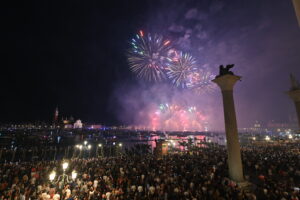
Since then, every third Sunday in July, a floating votive bridge is built between the Zattere and Giudecca to allow the faithful to reach the basilica on foot. On the night between Saturday and Sunday, a constellation of boats completely covers St. Marco’s basin and thousands of people crowd the foundations and banks of the city to admire the fires that light up the sky and are reflected on the water.
Venetian bubbles par excellence
Being present at this event, as the official bubble of the city of Venice, represents for the Prosecco DOC Consortium the recognition of the authentic bond with the territory and its traditions, a bond that is renewed year after year, glass after glass.
The journey curated by the Consorzio Prosecco DOC in collaboration with the Vinibuoni d’Italia Guide concludes in Liguria, amidst the coastal aromas and the essential purity of fine cuisine. The spotlight is on Enrico Marmo, born in 1987, Michelin-starred chef at Balzi Rossi in Ventimiglia.
His cooking is direct and pure, built around a few rigorously selected ingredients, enhanced with exceptional sensitivity. Raised on his grandmothers’ recipes and shaped in the kitchens of Cracco and Palluda, Marmo now leads a deeply personal cuisine that speaks of the Ligurian sea and land.
The Recipe: Sanremo Red Prawns, Peas, and Caviar
Balzi Rossi – VENTIMIGLIA (IM)
Ingredients:
16 purple Sanremo prawns – 50 g shelled peas – 200 g pea pods – 30 g shallot – 50 g butter – 30 g white wine – 50 g cream – 30 g Beluga Amur caviar – 30 g spring onion oil – salt – nasturtium leaves and flowers
A dish that captivates with elegance and purity. Lightly seared Sanremo red prawns are paired with fresh peas dressed in spring onion oil and a beurre blanc made from the pea pods. The final touch of Beluga caviar adds a noble and savory element.
The dish plays with sweetness, savoriness, creaminess, and vegetal notes. The delicacy of the prawn is elevated by measured contrasts, while the pea cream and caviar create an intense yet balanced flavor profile.
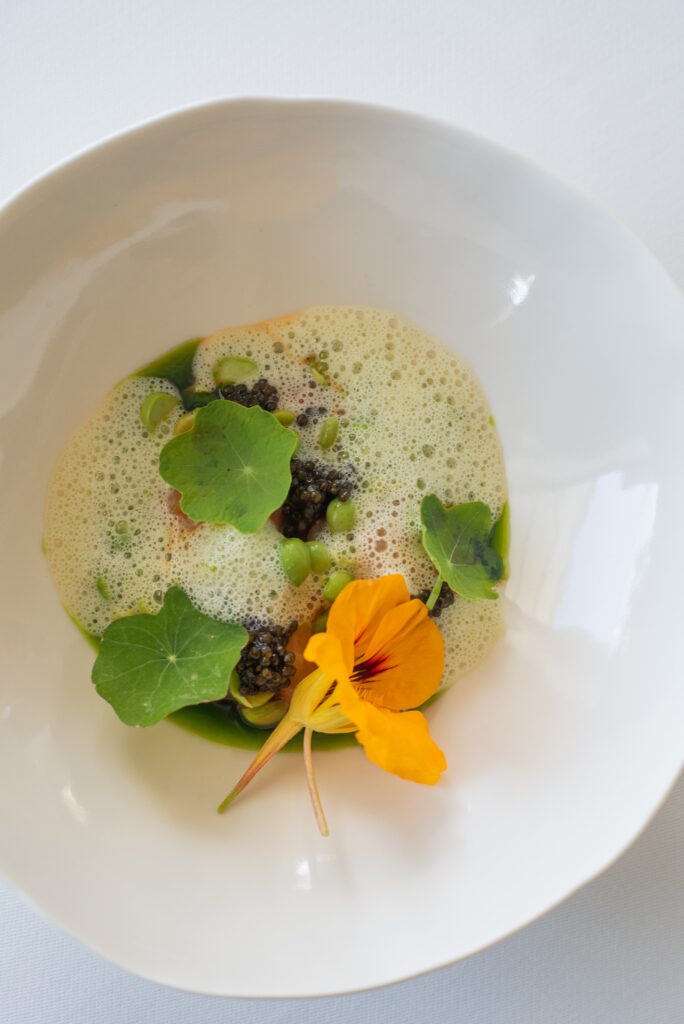
Preparation:
To make the pea pod beurre blanc, sweat the shallot in butter, deglaze with white wine. Once the wine has evaporated, add the pea pods and cream. Cook for 5 minutes. Blend, strain, and keep warm.
Season the peas with spring onion oil and salt. Clean the prawns, removing the heads and intestines. Season with salt and spring onion oil.
Plate the seasoned peas and prawns. Froth the beurre blanc with an immersion blender and add two spoonfuls to the dish. Finish with Beluga caviar and, if desired, nasturtium leaves and flowers.
Pairing: Prosecco DOC Rosé Brut
To complement this refined dish, a Prosecco DOC Rosé is the perfect match. Its fine bubbles, light structure, and delicate fruitiness harmonize beautifully with the sweetness of the prawn and the richness of the beurre blanc. The caviar, with its long and persistent savoriness, finds in the Prosecco DOC Rosé Brut a companion that enhances its elegance without overpowering it.
A classy pairing that brings to a graceful close this journey through the flavors and excellence of contemporary Italian cuisine.
The collaboration between the Vinibuoni d’Italia Guide and the Consorzio Prosecco DOC introduces us to chefs and dishes that showcase the best of Italy’s culinary heritage. And when it comes to maritime tradition and Mediterranean identity, Cetara is an essential stop.
Here we find the Torrente family, with Pasquale and his son Gaetano preserving and reinterpreting the legacy of the “Al Convento” restaurant, now transformed into “Casa Torrente.” Their cuisine celebrates the sea of the Amalfi Coast, with a deep respect for raw ingredients and preparations rooted in centuries of history.
The Recipe:
Spaghetti with Traditional Anchovy Drizzle from Cetara
Al Convento – CETARA (SA)
Ingredients:
400 g spaghetti – 1 garlic clove – extra virgin olive oil – parsley – traditional Colatura di alici from Cetara
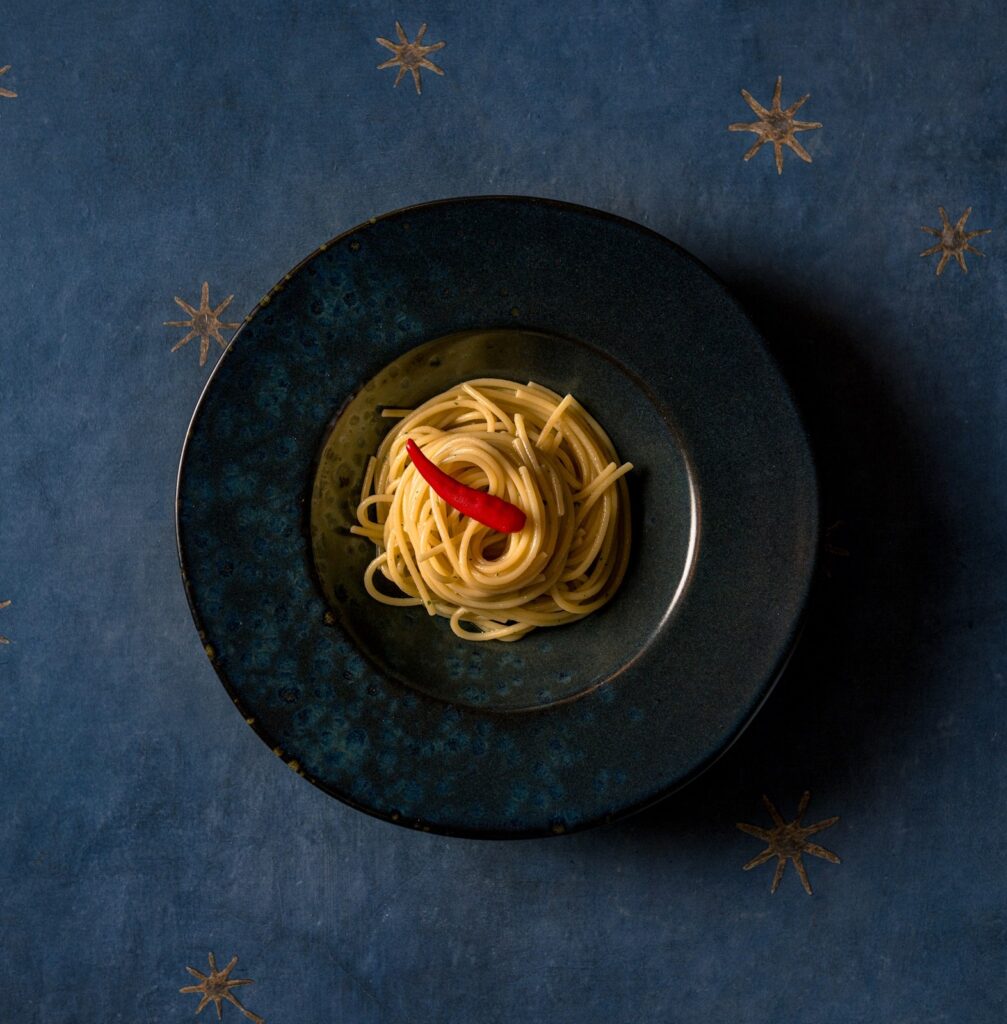
This dish is almost a culinary manifesto. Just a few ingredients — spaghetti, extra virgin olive oil, garlic, and anchovy drizzle — create an explosion of flavor. The colatura, an iconic product of the village, is measured with care to enhance rather than overpower the sweetness of the pasta and the aroma of the oil.
It’s a preparation that thrives on balance and restraint, where marine salinity meets the delicacy of tradition. A seemingly simple cuisine that actually requires deep knowledge and respect for each element.
Preparation:
In a pan or large bowl, combine garlic, olive oil, and one teaspoon of traditional Colatura di alici di Cetara per person. Add a ladle of pasta water — from a pot of unsalted water brought to a boil. Stir the mixture clockwise until the ingredients are well emulsified.
Cook the pasta in unsalted water, drain it al dente, and toss it with the sauce off the heat. Taste and, if needed, add a few more drops of anchovy drizzle to reach the desired level of salinity according to personal taste.
Pairing: Prosecco DOC Brut
To complement the savory intensity of the anchovy drizzle and the natural sweetness of the pasta, Alessandro Scorsone recommends a Prosecco DOC Brut. Its freshness and fine bubbles are ideal for cleansing the palate and enhancing the pleasure of each new bite.
A wine that elevates the sea on the plate without overshadowing it — Prosecco becomes a valuable ally of the most authentic regional cuisine.
As part of the joint project between the Consorzio Prosecco DOC and the Vinibuoni d’Italia Guide, each featured chef brings with them a story, a territory, and an authentic interpretation of Italian cuisine. The dialogue between dish and glass becomes a narrative — one of a culinary identity that evolves while staying true to its roots.
In Piedmont, a land of excellence and elegance, we meet Ugo Alciati. Heir to a great family tradition — that of Guido and Lidia Alciati — Ugo has made precision and respect for ingredients the core of his philosophy. His cuisine speaks the language of the Langhe and Monferrato, while remaining both contemporary and meticulous.
The Recipe:
40-Yolk Tagliatelle with Alba White Truffle
Guido Ristorante – SERRALUNGA D’ALBA (CN)
For the pasta:
500 g 00 flour – 350 g egg yolks
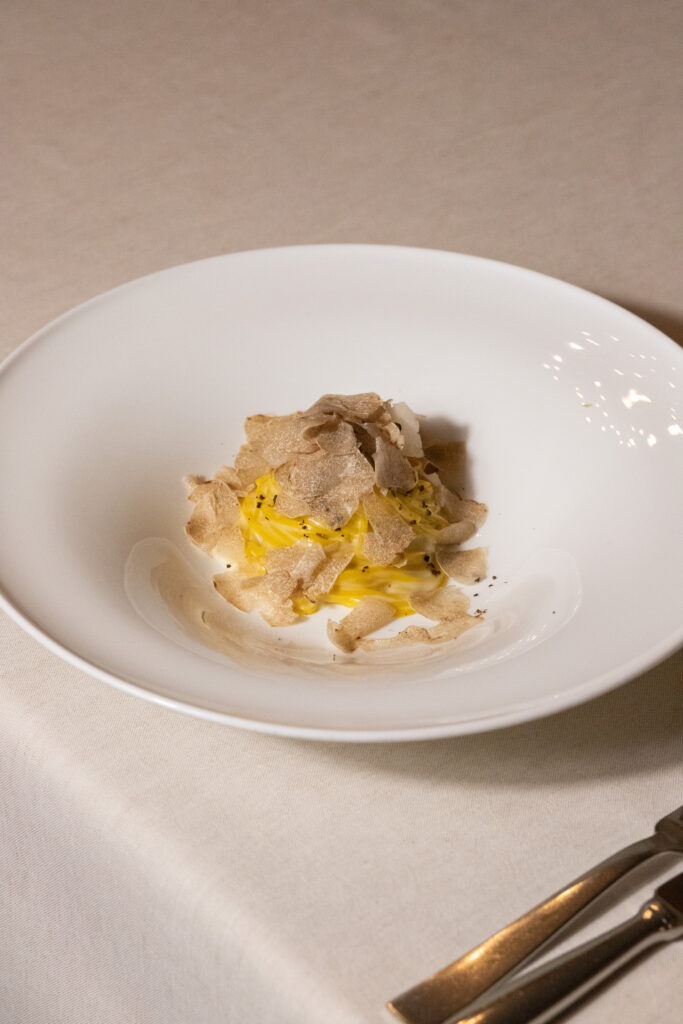
For the brine:
1 L water – 50–60 g salt – 25 g white truffle per 300 g water
A symbol of opulence and refinement, this dish revolves around two key elements: the richness of the egg pasta — made with an astounding 40 yolks — and the extraordinary aroma of Alba white truffle. A first course that needs nothing more than its own essence: few ingredients, exceptional quality, and great technique.
The truffle takes center stage with its unmistakable intensity, while the pasta brings sweetness and texture. An iconic dish that tells the story of the noble heritage of Piedmontese cuisine.
Preparation:
Mix the flour and yolks, then roll the dough into sheets about 1 mm thick. Let dry for about 15 minutes, then cut using a tagliatelle cutter or by hand. Leave to dry in a cool place for at least 3–4 hours.
For the brine, boil water with salt, pour into 300 g jars, and add 25 g of chopped white truffle. Pasteurize in a steam oven at 85 °C for 25 minutes.
Cook the tagliatelle in salted water for about 4 minutes. Drain, reserving about two tablespoons of cooking water. In a pan, combine the brine and fresh butter to create an emulsion. Serve the tagliatelle topped with thin shavings of Alba white truffle.
Pairing: Prosecco DOC Brut Nature
To accompany such an aromatic explosion, Alessandro Scorsone recommends a Prosecco DOC Brut Nature. Dry, vertical, with fine and clean aromas, it’s the perfect partner to avoid overshadowing the truffle’s fragrance. The wine enhances the dish’s persistence and balances its richness, without ever dominating it.
A pairing based on subtlety, where the Prosecco becomes a discreet and refined interpreter, allowing the dish to tell its own story.
